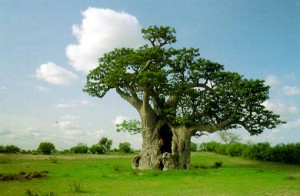Thoughts of Trees
08.06.10 · Greteman Group
Beastly summer heat has me thinking about a tree. Africa’s baobab. It thrives in punishing temperatures and drought. And sustains both man and beast. It can live to be 1,000 years old with a mass of limbs 150 feet across.
It’s a strange giant with branches that look like roots reaching up to the sky. Bushmen legend tells how, in a frivolous mood, the gods tossed the baobab to the Earth below where it landed. Wrong side up. Bushmen still believe that the baobab doesn’t grow like other trees, but crashes to the ground fully grown.
Shelter in the Storm
The baobab plays a large role in the ecosystem of the African savannah. Birds make homes in its hollows. Bush babies and fruit bats drink nectar from its large, white flowers. Baboons feast on its protein-rich fruit. Giraffes nibble its leaves.
Man uses it, too. Its fibrous bark makes string, rope, baskets, paper, cloth and netting. Its foot-long fruit creates a refreshing drink. Leaves can be boiled and eaten and glue made from the pollen. Various parts of the tree are used to reduce malaria fever and a host of other ailments. Its 30-foot-wide trunk has been used for everything from bus stops to storage barns. Whole villages can revolve around a particular tree.
Made in the Shade
Superstition surrounds the tree. It develops a hollow trunk said to be inhabited by spirits who haunt anyone foolish enough to cut it down. It’s revered as a repository for ancestral souls and the community’s spiritual power. Some believe that if you pick a flower from a baobab, you will be eaten by a lion; but if you drink water in which a Baobab’s seeds have been soaked, you’ll be safe from a crocodile attack.
Baobabs are hard to kill. They can be burnt and stripped of bark but quickly regenerate. When they do die, they rot from the inside and suddenly collapse with great noise, leaving behind only a heap of fiber. Many believe that they don’t die at all, but simply disappear as mysteriously as they arrive. Maybe the heat’s finally getting to me. But I want to live in the shade of the baobab.
